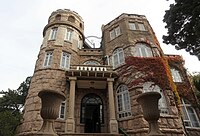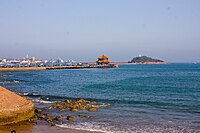Qingdao
Qingdao
青岛市 Tsingtao | ||
|---|---|---|
Sub-provincial city | ||
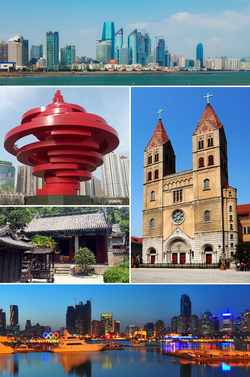 Clockwise from top left: Qingdao's skyline, St. Michael's Cathedral, Qingdao harbor, a temple at the base of Mount Lao, and May Fourth Square | ||
|
Coastline
| ||
| Major County-level divisions | 10 | |
| Climate | Dwa/Cwa | |
| Website | qingdao.gov.cn | |
| Symbols | ||
| Flower | China rose Camellia | |
| Tree | Cedrus | |
| Qingdao | ||
|---|---|---|
Tâi-lô | Tsheng-tó | |
Qingdao
Qingdao is a major
In the 2020 Global Financial Centers Index, Qingdao ranked 47th; the index is published by the Z/Yen Group and China Development Institute, the other Chinese cities on the list being Shanghai, Hong Kong, Beijing, Shenzhen, Guangzhou, Chengdu, Nanjing, Xi'an, Tianjin, Hangzhou, Dalian, and Wuhan.[10] In 2007, Qingdao was named as one of China's top ten cities by the Chinese Cities Brand Value Report, which was released at the 2007 Beijing Summit of China Cities Forum.[11] In 2009, Qingdao was named China's most livable city by the Chinese Institute of City Competitiveness.[12][13] In 2018, Qingdao held the Shanghai Cooperation Organisation summit.[14] In 2020, Qingdao was rated as a Gamma+ level global city by the Globalization and World Cities Research Network.[15]
Qingdao is also one of the world's top 50 cities for global scientific research as tracked by the Nature Index.[16] The city is home to several notable universities, including the Ocean University of China, China University of Petroleum, Shandong University of Science and Technology, Qingdao, Qingdao University of Science and Technology Qingdao University of Technology, and Qingdao Agricultural University.[17]
History
Antiquity
Human settlement in the area dates back 6,000 years. The
German and Japanese occupations


In 1891, the Qing Empire decided to make coastal Qingdao (then known as "Jiao'ao") a defense base against naval attacks and began to improve its fortifications.
Identified by the German authorities as a strategically important port, Qingdao was administered by the
- Siege of Tsingtao
- 10 sen (1914)
Before the outbreak of
After a minor British naval attack on the German concession in Shandong (
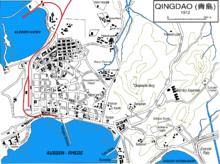
The city came under Chinese rule in December 1922, under control of the
Japan re-occupied Qingdao in 1938, a year after it expanded the
Qingdao city planning and development
1898–1914
The development of the Qingdao urban space during the German occupation (1898–1914) originated from the port. Mass urban construction began in 1898 with the relocation of Chinese dwellers along the coast.
1914–1922
The development of Tsingtao urban space continued during the first Japan-occupation period (1914–1922). In 1914, Tsingtao was taken over by the Japanese and served as a base for the exploitation of natural resources of Shandong and northern China. With the development of industry and commerce, a "New City District" was established to furnish the Japanese colonists with commercial sections and living quarters, which suggested a striking contrast to the shabby houses in the local Chinese zones (Li 2007, p. 133). In the meantime, several schools, hospitals, and public buildings were constructed, followed by urban streets and intercity highways as well. The urban spatial layout continued to expand northward along the east bay area.
1922–1938
The development of Tsingtao urban space during the ROC-ruled period (1922–1938). This period saw the substantial progress of the urban development of Tsingtao. The government engaged itself in mass construction that gave birth to villa districts at the beach and bank groups in CBD. Plenty of public buildings and facilities for entertainment and sports were completed. By the year 1937, the urban population numbered 385,000(Lu 2001, p. 327). Tsingtao consequently distinguished itself as a prominent holiday resort and summer retreat.
1938–1945
The development of Tsingtao urban space during the second Japan-occupied period (1938–1945). Japanese armed forces returned to Tsingtao in 1938 and started to strive for the construction of the Greater Tsingtao in the following June. Accordingly, they worked out the city planning of the Greater Tsingtao and the City Planning of the Mother Town (Tsingtao City Proper), even though they had not had the opportunity to actualize either, respectively. The period in question did not witness much urban progress except for the logical construction of No. 6 Wharf, some Japanese residences, and a small number of roads and streets (Lu 2001, p. 339).
Postwar
After World War II, the
Since the 1984 inauguration of China's open-door policy to foreign trade and investment, Qingdao has rapidly developed into an ultramodern port city. It is now the headquarters of the Chinese navy's northern fleet. An early example of the open-door policy occurred on 5 November 1984, when three United States Naval vessels visited Qingdao. This was the first US port call to China in more than 37 years. USS Rentz, USS Reeves, and USS Oldendorf and their crews were officially hosted by the Chinese People's Liberation Army Navy (PLAN).
Northern Qingdao, particularly

Administrative divisions

The sub-provincial city of Qingdao has seven districts (区; qū) and three county-level cities (市; shì):Qingdao City, located in Shandong Province, China, is a prefecture-level city with several aliases, including "Island City" and "Jiaozhou Bay." Qingdao is a vice-provincial-level city, a separately listed city, and recognized as a major city. According to the approval of the State Council, Qingdao is designated as an important coastal center city and a coastal resort tourism city in China, as well as an international port city. Qingdao City administers 7 districts and 3 county-level cities. These districts include Shinan District, Shibei District, Huangdao District, Laoshan District, Licang District, Chengyang District, and Jimo District, while the county-level cities consist of Jiaozhou City, Pingdu City, and Laixi City.
| Subdivision | Simplified ) |
Pinyin Romanization | Admin. Code[33] |
Land Area (km2) |
Urbanization Rate (%) |
Permanent Resident Population ('000s, 2010) |
Population Density (1/km2) |

1 2 Licang Huangdao Xihai'an Laoshan Chengyang Jimo Pingdu (city) Laixi (city) 1. Shinan 2. Shibei |
|---|---|---|---|---|---|---|---|---|
Districts
| ||||||||
Shinan District (city seat) |
市南区 | Shìnán Qū | 370202 | 30.01 | 100 | 544.8 | 18153.95 | |
Shibei District |
市北区 | Shìběi Qū | 370203 | 63.18 | 100 | 1020.7 | 16155.43 | |
Huangdao District (Xihai'an New Area) |
黄岛区 (西海岸新区) |
Huángdǎo Qū (Xīhǎi'àn Xīnqū) |
370211 | 2220.10 | 80 | 1392.6 | 627.27 | |
Laoshan District |
崂山区 | Láoshān Qū | 370212 | 389.34 | 80 | 379.5 | 974.73 | |
Licang District |
李沧区 | Lǐcāng Qū | 370213 | 95.52 | 100 | 512.4 | 5364.32 | |
Chengyang District |
城阳区 | Chéngyáng Qū | 370214 | 553.20 | 80 | 737.2 | 1332.61 | |
Jimo District |
即墨区 | Jímò Qū | 370282 | 1727 | 58.1 | 1177.2 | 681.64 | |
| County-level cities | ||||||||
| Jiaozhou | 胶州市 | Jiāozhōu Shì | 370281 | 1210 | 68.0 | 843.1 | 696.78 | |
| Pingdu | 平度市 | Píngdù Shì | 370283 | 3166 | 52.8 | 1357.4 | 428.74 | |
| Laixi | 莱西市 | Láixī Shì | 370285 | 1522 | 58.1 | 750.2 | 492.90 | |
Geographically, there are three districts (Shinan, Shibei, Licang) constituting a peninsula on the east coast of the Jiaozhou Bay as the core urban area, one (Chengyang) on the north coast and one (Xihai'an) on the west coast of the Yellow Sea.
- Defunct - Huangdao District(December 2012)
Geography

Climate
Qingdao has a temperate, four-season,
During the summer months, the beaches of Qingdao are afflicted by massive algal blooms. The decomposing algae release large amounts of hydrogen sulfide gas, which produces an offensive "rotten egg" odor. Sea lettuce blooms, which are partially caused by seaweed farming in Jiangsu Province, led local officials to declare a "large-scale algae disaster" in 2013.[38]
| Climate data for Qingdao (1991–2020 normals) | |||||||||||||
|---|---|---|---|---|---|---|---|---|---|---|---|---|---|
| Month | Jan | Feb | Mar | Apr | May | Jun | Jul | Aug | Sep | Oct | Nov | Dec | Year |
| Record high °C (°F) | 12.9 (55.2) |
19.6 (67.3) |
21.5 (70.7) |
25.2 (77.4) |
34.2 (93.6) |
34.4 (93.9) |
37.4 (99.3) |
34.3 (93.7) |
33.2 (91.8) |
28.4 (83.1) |
22.1 (71.8) |
16.2 (61.2) |
37.4 (99.3) |
| Mean daily maximum °C (°F) | 3.4 (38.1) |
5.6 (42.1) |
10.0 (50.0) |
15.7 (60.3) |
21.1 (70.0) |
24.3 (75.7) |
27.6 (81.7) |
28.7 (83.7) |
25.8 (78.4) |
20.2 (68.4) |
12.8 (55.0) |
5.9 (42.6) |
16.8 (62.2) |
| Daily mean °C (°F) | 0.2 (32.4) |
2.1 (35.8) |
6.2 (43.2) |
11.6 (52.9) |
17.1 (62.8) |
20.8 (69.4) |
24.7 (76.5) |
25.6 (78.1) |
22.3 (72.1) |
16.6 (61.9) |
9.5 (49.1) |
2.7 (36.9) |
13.3 (55.9) |
| Mean daily minimum °C (°F) | −2.4 (27.7) |
−0.6 (30.9) |
3.4 (38.1) |
8.7 (47.7) |
14.1 (57.4) |
18.5 (65.3) |
22.7 (72.9) |
23.4 (74.1) |
19.5 (67.1) |
13.7 (56.7) |
6.7 (44.1) |
0.1 (32.2) |
10.7 (51.2) |
| Record low °C (°F) | −14.3 (6.3) |
−12.1 (10.2) |
−6.2 (20.8) |
−1.6 (29.1) |
6.1 (43.0) |
12.0 (53.6) |
13.6 (56.5) |
16.3 (61.3) |
10.1 (50.2) |
1.9 (35.4) |
−7.2 (19.0) |
−11.3 (11.7) |
−14.3 (6.3) |
| Average precipitation mm (inches) | 10.3 (0.41) |
15.7 (0.62) |
18.0 (0.71) |
34.0 (1.34) |
64.1 (2.52) |
70.7 (2.78) |
159.1 (6.26) |
159.6 (6.28) |
69.4 (2.73) |
35.5 (1.40) |
35.2 (1.39) |
14.8 (0.58) |
686.4 (27.02) |
| Average precipitation days (≥ 0.1 mm) | 2.8 | 4.0 | 4.6 | 6.5 | 7.7 | 8.7 | 11.6 | 10.9 | 7.2 | 5.3 | 5.2 | 3.6 | 78.1 |
| Average snowy days | 3.8 | 3.3 | 1.6 | 0.2 | 0 | 0 | 0 | 0 | 0 | 0 | 0.7 | 2.7 | 12.3 |
| Average relative humidity (%)
|
63 | 65 | 65 | 67 | 71 | 82 | 86 | 82 | 71 | 64 | 64 | 63 | 70 |
| Mean monthly sunshine hours | 160.4 | 164.9 | 208.6 | 219.1 | 234.3 | 186.0 | 168.3 | 194.5 | 201.1 | 202.1 | 163.4 | 158.5 | 2,261.2 |
| Percent possible sunshine | 52 | 53 | 56 | 56 | 54 | 43 | 38 | 47 | 55 | 59 | 54 | 53 | 52 |
| Average ultraviolet index | 2 | 3 | 5 | 7 | 9 | 9 | 10 | 9 | 7 | 5 | 3 | 1 | 6 |
| Source 1: China Meteorological Administration[39][40] | |||||||||||||
| Source 2: Weather China[41] Weather Atlas (UV index)[42] | |||||||||||||
Graphs are unavailable due to technical issues. There is more info on Phabricator and on MediaWiki.org. |
See or edit raw graph data.
Demographics
| Year | Pop. | ±% |
|---|---|---|
| 1913[43] | 58,000 | — |
| 1953 | 916,846 | +1480.8% |
| 1964 | 1,383,433 | +50.9% |
| 1982 | 4,227,594 | +205.6% |
| 1990 | 6,663,989 | +57.6% |
| 2000 | 7,494,194 | +12.5% |
| 2010 | 8,715,100 | +16.3% |
| 2020 | 9,499,800 | +9.0% |
| Population size may be affected by changes in administrative divisions. | ||
Of the 10 million residents of Qingdao, 6.2 million reside in the Qingdao urban area. Another estimated 5 million live in other cities under Qingdao's jurisdiction.
There is a large Korean community in Qingdao. By 2009, there were approximately 100,000 Koreans working, studying and living in Qingdao, which makes Qingdao the second in terms of Korean population in China, following Beijing which has about 200,000 Koreans.[45]
Economy

In recent years, an important region in Eastern China, Shandong Province has seen substantial change in its economic landscape. Much of this development has been concentrated in Qingdao.[46] Qingdao has seen rapid development. With an annual growth rate of 18.9 percent in 2006, the city's GDP reached 42.3 billion, ranking first in Shandong Province and tenth out of China's top 20 cities.[46] GDP per capita comprised CN¥52,895 (US$7,616) in 2008. The GDP has grown steadily at an average pace of 16% annually. In 2006, Qingdao was ranked one of six "golden cities" by the World Bank, out of 120 Chinese cities assessed on factors including investment climate and government effectiveness.[46] In 2018, Qingdao's GDP reached CN¥1200.15 billion, though it shrank a little in 2019.[47]
Internationally, Qingdao is perhaps best known for its
In 1984 the Chinese government named a district of Qingdao a
Qingdao's wind power electricity generation performs at among the highest levels in the region.[49]
Industrial zones
- Qingdao West Coast New District
- Qingdao Special Economic and Technological Development Area
- Qingdao Free Trade Zone
- Qingdao High-tech Industrial Zone
- Qingdao University Industrial Zone
Transport
Road
There are a total of 1,145 km (711 mi) of roads in the Qingdao area, with nearly 500 km (310 mi) of expressways. These National Trunk Highway System (NTHS) Expressways begin or pass through in Qingdao.[50] Expressways that begin in Qingdao are in Bold:
- G15 )
- G18 Rongwu Expressway (Rongcheng, Shandong-Wuhai, Inner Mongolia)
- G20 Qingyin Expressway (Qingdao-Yinchuan, Ningxia)
Spur Route: G2011 Qingxin Expressway (Qingdao-Xinhe, Pingdu, Shandong)
- G22 Qinglan Expressway (Qingdao-Lanzhou, Gansu)
These provincial expressways begin in or pass through Qingdao. Expressways that begin in Qingdao are in Bold:
- S16 Rongwei Expressway (Rongcheng-Weifang)
- S19 Longqing Expressway (Longkou-Qingdao)
- S21 Xinwei Expressway (Xinhe-Weifang)
- S24 Weiqing Expressway (Weihai-Qingdao)
Other than Expressways, there are also National Highways that pass through or begin in Qingdao. National Highways that begin in Qingdao are in bold:
On 30 June 2011, the longest bridge over water opened in Qingdao. The bridge,
Marine
Qingdao (official name: Qingdao port international co. ltd.) hosts one of the world's busiest
By 2011, the port had become the world's sixth-busiest by Total Cargo Volume, having handled 372,000,000 metric tons (366,000,000 long tons; 410,000,000 short tons) of cargo in that year. As of 2016, it was the 8th in the world in terms of TEUs (Twenty Foot Equivalent Units).[55]
The Orient Ferry connects Qingdao with
Qingdao port also includes a number of large adjacent ports including Dongjiakou.[57]
Aviation
Intercity rail

Qingdao's railway development picked up during the late 1990s. It is at the start of the Jinan–Qingdao high-speed railway, the Qingdao–Jinan passenger railway and the original Qingdao–Jinan railway. Qingdao's city proper has some major railway stations, including Qingdao railway station, Cangkou railway station, Dagang railway station and Qingdao North railway station.[59] Sifang railway station is now closed to passengers.[60]
D and G series high-speed trains travel on the Jinan–Qingdao high-speed railway and reach speeds of 300 km/h (190 mph) on the Jinan-Qingdao Section.[61] Services go to Beijing, Shanghai, Hefei, Jinan and Tianjin.[62] The fastest train between Qingdao and Beijing is G206 / G205, which takes 2 hours and 58 minutes.[63]
Domestic rail lines connect Qingdao with many cities in China, including
Public transport

Qingdao's public traffic owns 5283 large and medium-sized buses,
), which uses radio frequencies so the card does not have to physically touch the scanner. After that, all public transportation companies use Qingdaotong Card, the last company that started to use this card is the Zhenqing bus company located in The West Coast New Area of Qingdao (original Huangdao Distinct) in 2019.Non air-conditioned buses cost 1 yuan (excluding the tunnel bus), The volume of road passenger transport approaches 737 million per year.[64] The Public Transport Brand of 'Ri-Xin Bus (日新巴士)' is also known in China.
There are several taxi companies in Qingdao including Yiqing Company, Zhongqing Company, Jiaoyun Company, and, Huaqing Company.
Metro[65]
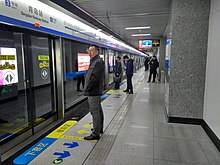
After getting the approval from the State Council, the government announced on 18 August 2009 that Qingdao is ready to spend more than 29 billion yuan ($4.2 billion) before 2016 on its subway construction. Construction of 54.7 km (34.0 mi) of subway line 3 was completed before 2016 with a total investment of 29.2 billion yuan ($4.3 billion). Metro Line 3 is the first line in function and opened on 16 December 2015. In the long term, the city plans to build eight subway lines in downtown and some suburban districts, which account for 231.5 km (143.8 mi) in future.[66] The system has an operating length of 243 km (151 mi), lines in operation including Line 1, Line 2, Line 3, Line 4, Line 8, Line 11, and Line 13.[65]
As of February 24, 2023, according to the approved network plan of Qingdao City, there are 19 long-term plans for Qingdao Metro, with a total length of 872 kilometers; The third phase construction plan has been approved, with a total of 13 lines and a total length of 503 kilometers, ranking ninth in the national approved mileage level; Seven lines have been opened and operated, including Lines 1, 2, 3, 4, 8, 11, and 13, with an operating mileage of 315 kilometers. As of March 2023, there are 146 operating stations, ranking tenth in China and second in northern cities; There are 10 lines under construction (including extension lines), including the West Extension and Phase II of Line 2, Line 5, Phase I and Phase II of Line 6, Phase II of Line 7, South Section and Branch of Line 8, Phase I of Line 9, and Phase I of Line 15. The total length under construction is 188 kilometers, and it is expected to be fully completed by 2028.
If you need information about Qingdao Metro, you can open the website of Qingdao Metro to help you.
Tramway
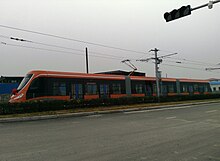
The Qingdao Tram (official name: Modern tram demonstration line) of Chengyang District, Qingdao, is a tram system operating in Chengyang District, Qingdao, China. It opened in 2016. The Qingdao Public Transport Group Rail Bus Co., Ltd. is responsible for operation and management. The system is only composed of 1 tram line.
Culture
Architecture

There are a large number of German-style buildings in Qingdao's


Notable people
- Long Ding, American football kicker
- James R. Lilley, U.S. diplomat
- Ma Jian (马建)
- Ma Jun (马军)
- Xiao Hong (萧红)
- Xiao Jun (萧军)
- Duanmu Hongliang (端木蕻良)
- Zou Chenglu (邹承鲁) was born in Qingdao
- Erin Pizzey, (was born in Qingdao)
- Li Zhaoxing (李肇星)
- Zhang Ruimin (张瑞敏)
- Victoria Song (宋茜, f(x))
- Huang Zitao (黄子韬, musician, actor)
- Huang Bo (黄渤)
- Zhang Jike (张继科)
- Gao Fenghan (高凤翰)
- Toshiro Mifune (was born in Qingdao)
- Li Cunxin(李存信)
- Huang Xiaoming (黄晓明)
- Chen Hao (陈好)
- Xia Yu (夏雨)
- Fan Bingbing (范冰冰, born in Qingdao)
- Bai Baihe (白百合)
- Hao Haidong (郝海东)
- Qingdao Huanghai)
- Bu Xiangzhi (卜祥志, chess grandmaster)
- Zhang Juanjuan (张娟娟, archer)
- Malcolm H. Wiener, (was born in Qingdao)
- Ni Ping (倪萍)
- Tang Guoqiang (唐国强)
- Ren Jialun (任嘉伦)
- Chen Meng (陈梦)
Movies shot in Qingdao
- A Little Red Flower (送你一朵小红花 2020) 2020
- A Better Tomorrow 2018 (英雄本色2018) 2016
- The Great Wall (长城) 2016
- Underdog Fight (硬汉) 2008
- Underdog Fight II (硬汉 II) 2013
- Ocean Heaven (海洋天堂) 2010
- Beauty Remains (美人依旧) 2005
Language
During the city's leased-territory days, German, the official language, was rigorously taught and promoted. Since the demise of Germany's colonial empire after World War I, the German language is all but gone, leaving little impact on the local languages. A local accent known as Qingdao dialect (Chinese: 青岛话; pinyin: Qīngdǎo huà) distinguishes the residents of the city from those of the surrounding Shandong province. Due to the efforts by the city government to promote standard Mandarin, most educated people can speak standard Mandarin in addition to their native dialect. With reform policies and English teaching, some young citizens have been taught English and many can converse with English-speaking foreigners. Business and traffic signs in English are becoming more and more common.
Festivals
Notable festivals include:
- Qingdao International Horticultural Exposition 2014is the biggest international fair that has been held in the history of the city.
- Qingdao International Beer Festival in August/September, held annually since 1991.
Media
Qingdao previously had a large German community and a German garrison, so three German newspapers operated in Qingdao.
A 1912 publication of the
Bandao Broadcasting Media Corporation, a news and broadcasting agency was founded in 1999.[70]
Tourism
Qingdao attracts many tourists due to its seaside setting and temperate weather. Parks, beaches, sculptures, and unique German and modern architecture line the shore. Its centrally located tourist information center, the "Qingdao Information Center for International Visitors for International Visitors," is located on Middle Hong Kong Road (香港中路).
Qingdao's major attractions include:
Western Shinan district
- Zhan Qiao(Pier, 栈桥)
- Little Qingdao Isle (小青岛)
- Tian Hou Temple (天后宫), Qingdao Folk Museum
- Badaguan (八大关; 'Eight Great Passes'), the older area of town with some surviving German and Japanese architecture.
- Lu Xun Park, named after Lu Xun, modern Chinese writer and critic, who lived and taught in the 1930s.
- Zhongshan Park, named after the style name 'Zhongshan' of Sun Yat-sen, a famous modern Chinese politician.
- Xiao Yu Shan(小鱼山; 'Little Fish Hill')
- The twin-spired Neo-romanesquearchitecture, designed by German architect Alfred Fräbel, completed in 1934.
- Qingdao Aquarium (青岛水族馆)
- Jiaozhou Governor's Hall(提督府), the office building of former German governors (Gouverneurspalast) and former municipal government
- Xinhao Hill (信号山)
Eastern Shinan district
- May Fourth Square (Platz des vierten Mai), Coastal plaza with the Wind of May sculpture
- Tsingtao Brewery (Tsingtao-Brauerei), founded by Germany and the most exported beer from China.
- Zhanshan Temple (Dschanschan-Tempel), Qingdao's oldest Buddhist temple.
- Qingdao International Sailing Centre (青岛奥林匹克帆船中心), hosted the Olympic and Paralympic Sailing competitions in 2008.
Laoshan district
- Lao Shan (Mount Lao, Lauschan, 崂山), 40 km (25 mi) east of Qingdao, the most famous Taoist mountain with Taoist retreat – Great Purity Palace (太清宫)
- National Shilaoren Tourist Resort (石老人国家旅游度假区), the famous bathing beach symbolized by a characteristic natural sea rock with a shape like an old man
- Xiaomaidao Park (小麦岛公园), the park with hills, a beach, and a nice view of the coastal line
Education
Higher education
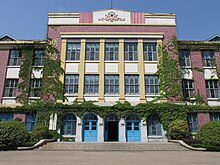
Qingdao is home to a large number of
- China University of Petroleum, completed its relocation from Dongyingto Qingdao in 2012
- Shandong University of Science and Technology, the main campus is based in Qingdao since 2003
- Qingdao Agricultural University, the main campus is based in Qingdao since 2007
- Qingdao Technical College
- Qingdao Binhai University, located at Huangdao.
International schools
- Korean International School of Qingdao
- Malvern College Qingdao
- Pegasus California School, Qingdao
- International School of Qingdao
- Qingdao Amerasia International School
- Qingdao No.1 International School
- Qingdao Oxford International College
- Yew Chung International School of Qingdao
- Belt&Road Collaborative Innovation College (BRCIC)[72]
Secondary schools
- Qingdao No. 2 High School
- Qingdao No. 58 School
- Qingdao No. 1 High School
- Qingdao No. 9 High School
- Qingdao No. 15 High School
- Qingdao No. 19 High School
- and so on
Sports
Stadiums
- Guoxin Gymnasium(Qingdao city sports center)
- Yizhong Sports Center
- Qingdao Tiantai Stadium
- Hongcheng Stadium
2008 Olympic Summer Games
During the 2008 Summer Olympics, Qingdao and Beijing cohosted the Olympic Sailing competitions.[73] In Qingdao, the events took place along the shoreline by the city. These events were hosted at the Qingdao International Sailing Centre and held in Fushan Bay, near the city's central business district. An international broadcasting center and purpose-built hotel were constructed for the Games.
Motorsport
The IndyCar Series signed a contract with the Qingdao city council to hold an IndyCar race in Qingdao in 2012. The subsequently canceled race was supposed to take place on a 6.23 km (3.87 mi) street circuit.[74][75]
Sister cities
Qingdao has 36 sister cities.[76]
| City | Country | Year of Agreement |
|---|---|---|
| Acapulco | 1985 | |
| Adelaide[77] | 2014 | |
| Bilbao | 2004 | |
| Daegu | 1993 | |
| Faisalabad | 2021[78] | |
| Galway | 1999 | |
| Iloilo City | 2003 | |
| Klaipėda | 2004 | |
Long Beach |
1985 | |
| Makassar | N/A | |
| Mannheim | 2016 | |
| Miami | 2005 | |
| Montevideo | 2004 | |
| Nantes | 2005 | |
Nes Ziyyona |
1997 | |
| North Shore City | 2008 | |
| Odesa | 1993 | |
| Paderborn | 2003 | |
| Perm | 2003 | |
| Puerto Montt | 1999 | |
| Regensburg | 2009 | |
| Richmond | 2008 | |
| Saint Petersburg | 2006 | |
| Shimonoseki | 1979 | |
| Southampton | 1998 | |
| Velsen | 1998 | |
| Vila Velha | 2009 | |
| Wilhelmshaven | 1992 | |
| Yerevan | 2023 |
See also
Notes
- ^ See East Asia Squadron, Battle of Coronel and Battle of the Falkland Islands for fleet engagements.
References
Citations
- ^ "China: Shāndōng (Prefectures, Cities, Districts and Counties) - Population Statistics, Charts and Map".
- ^ "Shandong Statistical Yearbook-2016". www.stats-sd.gov.cn.
- ^ 2017中国青岛青岛概况 - 中文 - 青岛之窗 - 让青岛走向世界,让世界了解青岛. www.qingdaochina.org. Archived from the original on 6 March 2019. Retrieved 4 March 2019.
- ^ 中央机构编制委员会印发《关于副省级市若干问题的意见》的通知. 中编发[1995]5号. 豆丁网. 19 February 1995. Archived from the original on 29 May 2014. Retrieved 28 May 2014.
- ^ "China: population of major cities 2021". Statista. Retrieved 7 February 2023.
- ISBN 978-7-5333-0653-3.
- ^ "山东省" [Shandong Province]. China Oceanic Information Network. National Ocean Information Center.
- ^ "China Beer" (PDF). Archived from the original (PDF) on 4 March 2016. Retrieved 13 June 2013.
- S2CID 225502755.
- ^ "The Global Financial Centres Index 28" (PDF). Long Finance. September 2020. Retrieved 26 September 2020.
- ^ "China's Top 10 Most Livable Cities". hnloudi.gov.cn. Hunan Loudi Official Government. 28 March 2012. Archived from the original on 10 April 2013. Retrieved 18 June 2014.
- ^ "List of 10 Most Livable Cities in China Issued". 9 July 2009. Archived from the original on 26 April 2011. Retrieved 18 December 2010.
- ^ Lin Liyao (蔺丽瑶) (27 July 2011). "Top 10 livable cities in China 2011". China.org.cn. Archived from the original on 23 September 2012. Retrieved 10 September 2012.
- ^ "China Focus: What to expect from SCO summit in Qingdao". Xinhua. Archived from the original on 29 June 2018. Retrieved 29 June 2018.
- ^ "The World According to GaWC 2020". GaWC - Research Network. Globalization and World Cities. Retrieved 31 August 2020.
- ^ "Leading 200 science cities | Nature Index 2023 Science Cities | Supplements | Nature Index". www.nature.com. Retrieved 22 November 2023.
- ^ "US News Best Global Universities Rankings in Qingdao". U.S. News & World Report. 26 October 2021. Retrieved 31 October 2021.
- ^ "Study in Qingdao". www.sicas.com.cn. Retrieved 29 March 2024.
- ^ "青岛" [Qingdao]. CCTV国家地理. National Ocean Information Center.
- ISBN 978-1-55750-309-1.
- ^ Matzat, Wilhelm (May 2003). "Landmann Gottfried 1860–1926 Uhrmacher, Optiker, Bierbrauer" [Gottfried Landmann, 1860–1926: Watchmaker, Optician, Beer Brewer]. tsingtau.org (in German). Wilhelm Matzat. Archived from the original on 28 July 2011. Retrieved 9 June 2010.
- ^ ISBN 978-3-8004-1094-1.
- ^ Matzat, Wilhelm (May 2003). "Germania Brauerei und ihre Angestellten 1903–1914" [Germania Brewery and its Employees]. tsingtau.org (in German). Wilhelm Matzat. Archived from the original on 12 August 2014. Retrieved 9 June 2010.
- ^ Li (李), Si (斯). 1904年06月01日 胶济铁路通车. www.todayonhistory.com. Archived from the original on 3 September 2014. Retrieved 1 September 2014.
- ^ Duffy, Michael (22 August 2009). "Primary Documents – Count Okuma on the Japanese Capture of Tsingtao, 15 August 1914". firstworldwar.com. Archived from the original on 7 August 2014. Retrieved 28 July 2014.
- ^ "Germans lose possessions in China". The Independent. 16 November 1914. Archived from the original on 30 December 2012. Retrieved 24 July 2012.
- ^ A. Whitney Griswold, The Far Eastern Policy of the United States (1938) pp. 239–68.
- ^ Griswold, The Far Eastern Policy of the United States (1938) pp. 326–28.
- ^ Toyokichi Iyenaga (26 October 1914). "What is Kiaochou worth?". The Independent. Archived from the original on 30 December 2012. Retrieved 24 July 2012.
- ^ Schultz-Naumann, p. 182
- ISBN 978-3-8004-1094-1.
- ^ Schultz-Naumann, p. 184
- National Bureau of Statistics of the People's Republic of China. 2016. Retrieved 1 February 2018.
统计用区划代码 名称 370201000000 市辖区 370202000000 市南区 370203000000 市北区 370211000000 黄岛区 370212000000 崂山区 370213000000 李沧区 370214000000 城阳区 370281000000 胶州市 370282000000 即墨市 370283000000 平度市 370285000000 莱西市
- ^ a b 自然地理 [Geography] (in Simplified Chinese). Qingdao: Shinan District Information Office. Archived from the original on 2 June 2010. Retrieved 29 June 2010.
- ^ "青岛地理气候特点-中国气象局政府门户网站". www.cma.gov.cn (in Chinese (China)). Retrieved 29 January 2023.
- ^ "无标题文档". Archived from the original on 18 March 2013. Retrieved 18 February 2013.
- ^ "Experience Template" CMA台站气候标准值(1991-2020) (in Chinese). China Meteorological Administration. Retrieved 11 April 2023.
- ^ Jacobs, Andrew (5 July 2013). "Huge Algae Bloom Afflicts Coastal Chinese City". The New York Times. Archived from the original on 9 July 2013. Retrieved 5 July 2013.
- ^ 中国气象数据网 – WeatherBk Data (in Simplified Chinese). China Meteorological Administration. Retrieved 12 August 2023.
- ^ "Experience Template" 中国气象数据网 (in Simplified Chinese). China Meteorological Administration. Retrieved 12 August 2023.
- ^ 青岛 - 气象数据 -中国天气网 (in Chinese). Weather China. Retrieved 1 June 2011.
- ^ "Qingdao, China - Detailed climate information and monthly weather forecast". Weather Atlas. Yu Media Group. Archived from the original on 9 July 2019. Retrieved 9 July 2019.
- ISBN 3-924603-05-7.
- ^ "Demographia World Urban Areas" (PDF). 2021.
- ^ 韩国旅客位居北京入境外国人之首. 8 October 2009. Archived from the original on 26 November 2009. Retrieved 1 December 2009.
- ^ a b c "Qingdao Shinan District Investment Environment Study 2007", Report, KPMG Huazhen, 2007, retrieved 10 June 2010[permanent dead link]
- ^ 2019年青岛GDP发布,含金量到底多少?|界面新闻. www.jiemian.com (in Chinese). Retrieved 23 February 2020.
- ^ "Gibson Qingdao Factory – All Epiphone... All The Time!". Epiphone.com. Archived from the original on 9 March 2012. Retrieved 24 February 2012.
- ^ Gardiner, Ginger (July 2007). "High Wind in China". www.compositesworld.com. Archived from the original on 25 May 2017. Retrieved 27 May 2017.
- ^ 中国公路信息服务网-公路地图 (in Simplified Chinese). 中国公路信息服务网. Archived from the original on 16 January 2013. Retrieved 12 January 2013.
- ^ Eimer, David (8 January 2011). "China builds world's longest bridge". The Telegraph. London. Archived from the original on 6 May 2018. Retrieved 23 March 2013.
- ^ New Qingdao model of BRI cooperation
- ^ Qingdao Port became the first port in the country whose sea-rail combined transport exceeded one mil
- ^ Qingdao port sees upsurge in cargo handling capacity Archived 10 March 2005 at the Wayback Machine. People's Daily. Retrieved on 2012-11-12.
- ^ "Ports & World Trade". www.aapa-ports.org. Archived from the original on 4 May 2011. Retrieved 3 July 2014.
- ^ Ferries Korea-China Archived 19 August 2010 at the Wayback Machine. Seat61.com. Retrieved on 2012-11-12.
- ^ "About Dongjiakou port". www.qingdao-port.com/. Qingdao Port International Co. Ltd. Archived from the original on 7 November 2017. Retrieved 31 October 2017.
- ^ "青岛胶东国际机场正式转场运营". 12 August 2021.
- ^ "Qingdao North Railway Station: Location, Trains, Transportation". www.travelchinaguide.com. Retrieved 15 June 2020.
- ^ For several years before August 2008, travelers not from Qingdao were often confused because railway tickets to Qingdao showed the destination as "Sifang". Those trains were headed to Qingdao's Sifang station as a temporary measure. Once renovations to the larger Qingdao Railway Station were complete, the name of the destination reverted to "Qingdao".
- ^ 杨传忠 (17 October 2012). 济青高铁建设近年无望 济青1小时生活圈得等等. Qilu Evening News (in Chinese (China)).
济南铁路局胶济客专公司一位负责人说,胶济客专的客运正线长362.5公里,设计速度最高250公里/小时,现在行车时速为200公里.
- ^ 列车时刻 (in Simplified Chinese). Qingdao railway station. Archived from the original on 8 January 2013. Retrieved 12 January 2013.
- ^ 民生追访:4月10日起青岛至北京一站直达 高铁票_555彩票_555彩票娱乐网_555彩票官方认证平台-首页. www.3box.cc. Retrieved 23 February 2020.
- ^ 青岛发布2018年社会责任报告 全年客运总量7.37亿人. qd.ifeng.com. Retrieved 23 February 2020.
- ^ a b "QINGDAO METRO". QINGDAO METRO.
- ^ "$4.3 billion budget to boost Qingdao subway construction". 19 August 2008. Archived from the original on 22 August 2009.
- ^ a b Walravens, p. 90 Archived 2 January 2016 at the Wayback Machine.
- ^ a b Walravens, p. 91 Archived 2 January 2016 at the Wayback Machine.
- United States Bureau of Foreign and Domestic Commerce, p. 188 Archived 2 January 2016 at the Wayback Machine. "Tageblatt für Nord China, a German paper published in Tientsin, and the leading papers published in Shanghai are also largely read in Tsingtau."
- ^ "青岛门户网站 半岛网(山东半岛最有影响力的网站)". Bandao.cn. Retrieved 3 May 2022.
- ^ "Qingdao University Ranking". US. News. 2021.
- ^ "Belt and Road Collaborative Innovation College". Archived from the original on 4 November 2018. Retrieved 4 November 2018.
- ^ "2008 Beijing Olympic Sailing Competition". sailing.org. Retrieved 24 June 2021.
- ^ IndyCar (10 November 2011). "INDYCAR: Series Confirms China Race". SPEED Channel. Fox Sports. Archived from the original on 13 November 2011. Retrieved 11 November 2011.
- ^ "IndyCar scheduled August race in China has been canceled". Washington Posts. Archived from the original on 15 December 2018. Retrieved 16 June 2012.
- ^ "Qingdao sister cities". Retrieved 12 April 2020.
- ^ "Qingdao - Sister city of Adelaide". Archived from the original on 19 July 2019. Retrieved 19 May 2020.
- ^ "Faisalabad, Qingdao sign Letter of Intent to develop sister city ties". Associated Press of Pakistan. 27 April 2021. Retrieved 28 April 2021.
Sources
- Gottschall, Terrell D. By Order of the Kaiser: Otto von Diederichs and the Rise of the Imperial German Navy 1865–1902. Annapolis: Naval Institute Press. 2003. ISBN 1-55750-309-5
- Schultz-Naumann, Joachim. Unter Kaisers Flagge: Deutschlands Schutzgebiete im Pazifik und in China einst und heute [Under the Kaiser's Flag, Germany's Protectorates in the Pacific and in China then and today]. Munich: Universitas Verlag. 1985.
- Miscellaneous series, Issues 7–11. Bureau of Foreign and Domestic Commerce, 1912.
- Walravens, Hartmut. "German Influence on the Press in China". In: Newspapers in International Librarianship: Papers Presented by the Newspaper Section at IFLA General Conferences. ISBN 9783110962796.
- Also available at the website of the Queens Library– This version does not include the footnotes visible in the Walter de Gruyter version.
- Also available in Walravens, Hartmut, and Edmund King. Newspapers in international librarianship: papers presented by the section of the newspaper at IFLA General Conferences. ISBN 9783598218378.
- Also available at the website of the
External links
- Qingdao Government website (in Chinese)
- Qingdao International Academician Port website (in Chinese)
- Study in China Admission System(中国高等院校国际招生管理服务系统) website (in English)


